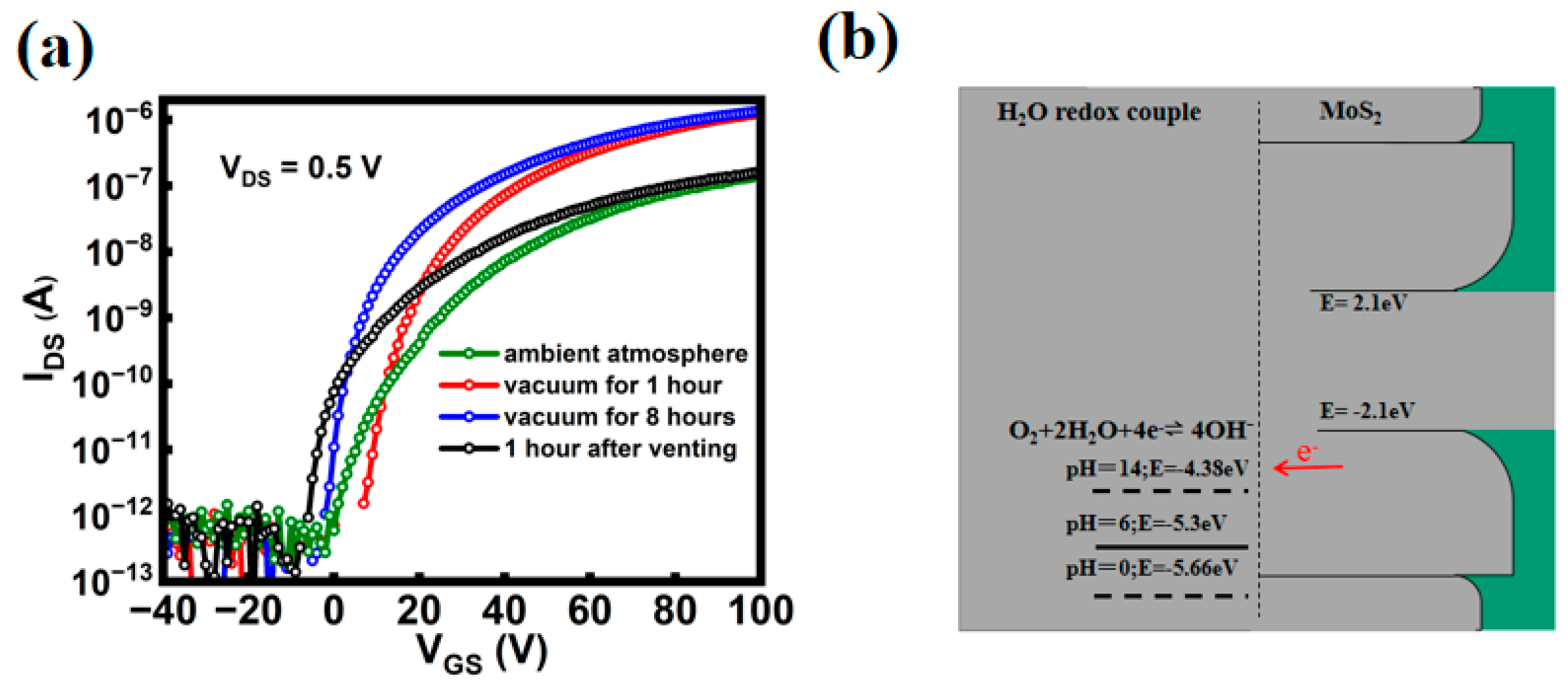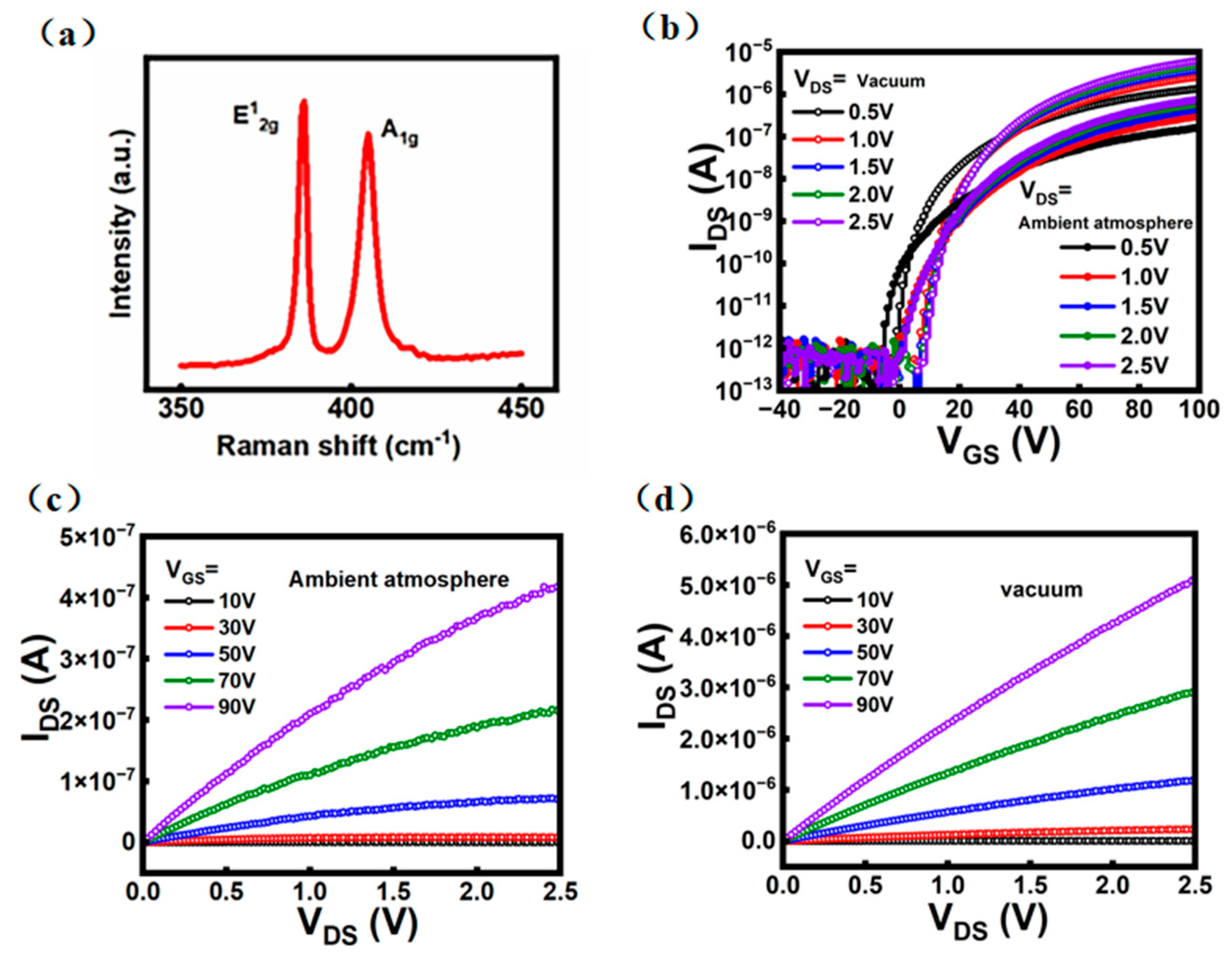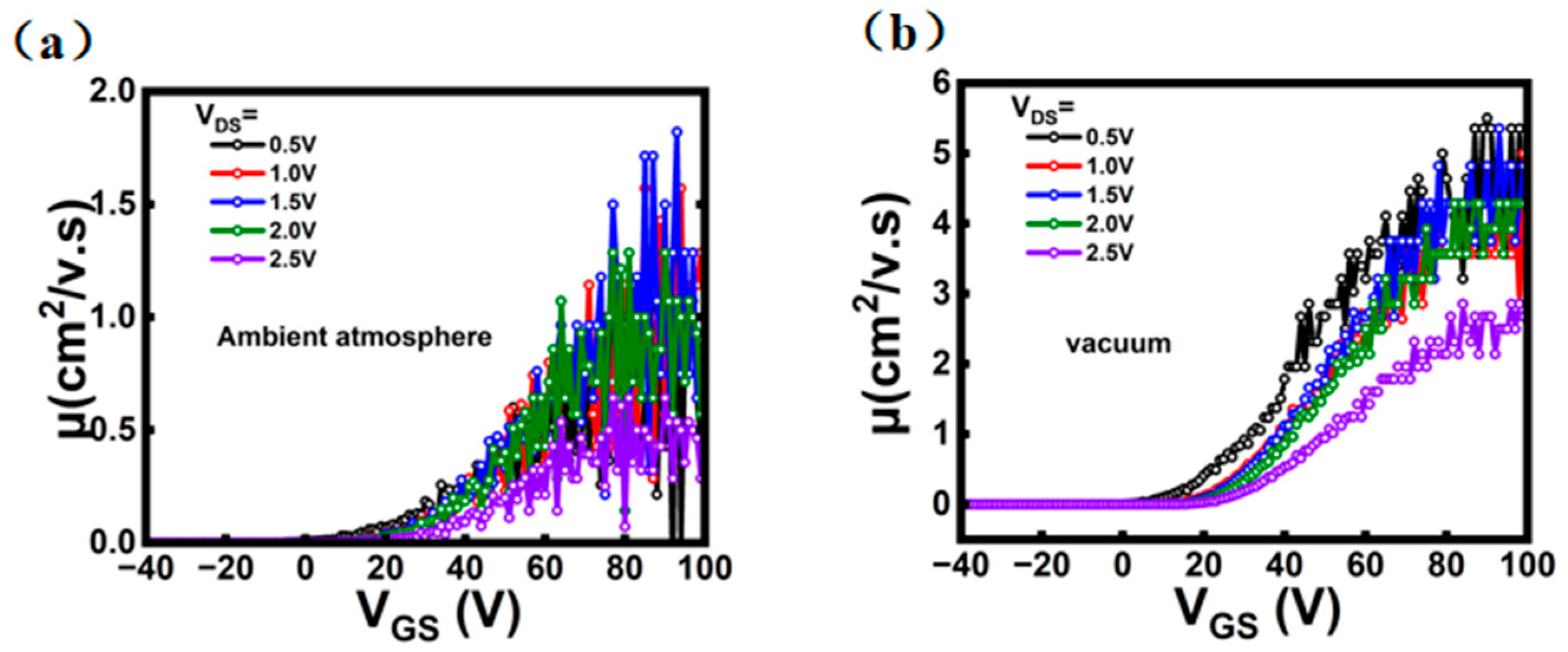The Effect of a Vacuum Environment on the Electrical Properties of a MoS2 Back-Gate Field Effect Transistor
Abstract
:1. Introduction
2. Experimental Section
3. Results and Discussion
4. Conclusions
Author Contributions
Funding
Institutional Review Board Statement
Informed Consent Statement
Data Availability Statement
Conflicts of Interest
References
- Jiang, J.; Ahyi, A.C.; Dhar, S. Dual-gate MoS2 FET with a coplanar-gate engineering. IEEE Trans. Electron Devices 2015, 63, 573–577. [Google Scholar] [CrossRef]
- Pan, Y.; Jia, K.; Huang, K.; Wu, Z.; Bai, G.; Yu, J.; Zhang, Z.; Zhang, Q.; Yin, H. Near-ideal subthreshold swing MoS2 back-gate transistors with an optimized ultrathin HfO2 dielectric layer. Nanotechnology 2019, 30, 96–98. [Google Scholar] [CrossRef] [PubMed]
- Lee, K.M.; Oh, Y.; Yoon, H.; Chang, M.; Kim, H. Multifunctional role of MoS2 in preparation of composite hydrogels: Radical initiation and cross-linking. ACS Appl. Mater. Interfaces 2020, 12, 8642–8649. [Google Scholar] [CrossRef] [PubMed]
- Radisavljevic, B.; Whitwick, M.B.; Kis, A. Integrated circuits and logic operations based on single-layer MoS2. ACS Nano 2011, 5, 9934–9938. [Google Scholar] [CrossRef]
- Bagsican, F.R.; Winchester, A.; Ghosh, S.; Zhang, X.; Ma, L.; Wang, M.; Murakami, H.; Talapatra, S.; Vajtai, R.; Ajayan, P.M.; et al. Adsorption energy of oxygen molecules on graphene and two-dimensional tungsten disulfide. Sci. Rep. 2017, 7, 1774–1779. [Google Scholar] [CrossRef]
- Tongay, S.; Zhou, J.; Ataca, C.; Liu, J.; Kang, J.S.; Matthews, T.S.; You, L.; Li, J.; Grossman, J.C.; Wu, J. Broad-range modulation of light emission in two-dimensional semiconductors by molecular physisorption gating. Nano Lett. 2013, 13, 2831–2836. [Google Scholar] [CrossRef]
- Wang, X.F.; Tian, H.; Liu, Y.; Shen, S.; Yan, Z.; Deng, N.; Yang, Y.; Ren, T.-L. Two-mode MoS2 filament transistor with extremely low subthreshold swing and record high on/off ratio. ACS Nano 2019, 13, 2205–2212. [Google Scholar] [CrossRef]
- Alexandrou, K.; Farmakis, F.; Arapis, A.; Georgoulas, N.; Hao, Y.; Hone, J.; Kymissis, I. Effect of vacuum thermal annealing to encapsulated graphene field effect transistors. J. Vac. Sci. Technol. B 2016, 34, 171–177. [Google Scholar] [CrossRef]
- English, C.D.; Shine, G.; Dorgan, V.E.; Saraswat, K.C.; Pop, E. Improved contacts to MoS2 transistors by ultra-high vacuum metal deposition. Nano Lett. 2016, 16, 3824–3830. [Google Scholar] [CrossRef]
- Nan, H.; Wang, Z.; Wang, W.; Liang, Z.; Lu, Y.; Chen, Q.; He, D.; Tan, P.; Miao, F.; Wang, X.; et al. Strong photoluminescence enhancement of MoS2 through defect engineering and oxygen bonding. ACS Nano 2014, 8, 5738–5745. [Google Scholar] [CrossRef]
- Sun, L.; Zhang, X.; Liu, F.; Shen, Y.; Fan, X.; Zheng, S.; Thong, J.T.L.; Liu, Z.; Yang, S.A.; Yang, H.Y. Vacuum level dependent photoluminescence in chemical vapor deposition-grown monolayer MoS2. Sci. Rep. 2017, 7, 16714. [Google Scholar] [CrossRef] [PubMed]
- Wang, X.; Kang, K.; Chen, S.; Du, R.; Yang, E.-H. Location-specific growth and transfer of arrayed MoS2 monolayers with controllable size. 2D Mater. 2017, 4, 025093. [Google Scholar] [CrossRef]
- Aguirre, C.M.; Levesque, P.L.; Paillet, M.; Lapointe, F.; St-Antoine, B.C.; Desjardins, P.; Martel, R. The role of the oxygen/water redox couple in suppressing electron conduction in field-effect transistors. APS March Meet. Abstr. 2009, 17, 24–32. [Google Scholar] [CrossRef]
- Chua, L.-L.; Zaumseil, J.; Chang, J.-F.; Ou, E.C.-W.; Ho, P.K.-H.; Sirringhaus, H.; Friend, R.H. General observation of n-type field-effect behaviour in organic semiconductors. Nature 2005, 434, 194–199. [Google Scholar] [CrossRef] [PubMed]
- Chakraborty, B.; Matte, H.S.S.R.; Sood, A.K.; Rao, C.N.R. Layer-dependent resonant Raman scattering of a few layer MoS2. J. Raman Spectrosc. 2013, 44, 92–96. [Google Scholar] [CrossRef]
- Qiu, H.; Pan, L.; Yao, Z.; Li, J.; Shi, Y.; Wang, X. Electrical characterization of back-gated bi-layer MoS2 field-effect transistors and the effect of ambient on their performances. Appl. Phys. Lett. 2012, 100, 2024–2027. [Google Scholar] [CrossRef]
- Cho, K.; Park, W.; Park, J.; Jeong, H.; Jang, J.; Kim, T.-Y.; Hong, W.-K.; Hong, S.; Lee, T. Electric stress-induced threshold voltage instability of multilayer MoS2 field effect transistors. ACS Nano 2013, 7, 7751–7758. [Google Scholar] [CrossRef]
- Iqbal, M.W.; Elahi, E.; Amin, A.; Aftab, S.; Aslam, I.; Hussain, G.; Shehzad, M.A. A facile route to enhance the mobility of MoTe2 field effect transistor via chemical doping. Superlattices Microstruct. 2020, 147, 106–114. [Google Scholar] [CrossRef]
- Yu, Z.; Ong, Z.-Y.; Li, S.; Xu, J.-B.; Zhang, G.; Zhang, Y.-W.; Shi, Y.; Wang, X. Analyzing the carrier mobility in transition-metal dichalcogenide MoS2 field-effect transistors. Adv. Funct. Mater. 2017, 27, 160–172. [Google Scholar] [CrossRef]
- Radisavljevic, B.; Kis, A. Mobility engineering and a metal–insulator transition in monolayer MoS2. Nat. Mater. 2013, 12, 815–820. [Google Scholar] [CrossRef]
- Kim, J.H.; Lee, J.; Kim, J.H.; Hwang, C.C.; Lee, C.; Park, J.Y. Work function variation of MoS2 atomic layers grown with chemical vapor deposition: The effects of thickness and the adsorption of water/oxygen molecules. Appl. Phys. Lett. 2015, 106, 1230–1238. [Google Scholar] [CrossRef]
- Qi, L.; Wang, Y.; Shen, L.; Wu, Y. Chemisorption-induced n-doping of MoS2 by oxygen. Appl. Phys. Lett. 2016, 108, 30–36. [Google Scholar] [CrossRef]
- Jiang, J.; Zhang, Y.; Wang, A.; Duan, J.; Ji, H.; Pang, J.; Sang, Y.; Feng, X.; Liu, H.; Han, L. Construction of high field-effect mobility multilayer MoS2 field-effect transistors with excellent stability through interface engineering. ACS Appl. Electron. Mater. 2020, 2, 2132–2140. [Google Scholar] [CrossRef]
- Majd, S.M.; Salimi, A.; Ghasemi, F. An ultrasensitive detection of miRNA-155 in breast cancer via direct hybridization assay using two-dimensional molybdenum disulfide field-effect transistor biosensor. Biosens. Bioelectron. 2018, 105, 6–13. [Google Scholar] [CrossRef]
- Singh, E.; Singh, P.; Kim, K.S.; Yeom, G.Y.; Nalwa, H.S. Flexible molybdenum disulfide (MoS2) atomic layers for wearable electronics and optoelectronics. ACS Appl. Mater. Interfaces 2019, 11, 11061–11105. [Google Scholar] [CrossRef]
- Huang, X.; Yao, Y.; Peng, S.; Zhang, D.; Shi, J.; Jin, Z. Effects of charge trapping at the MoS2–SiO2 interface on the stability of subthreshold swing of MoS2 field effect transistors. Materials 2020, 13, 2896. [Google Scholar] [CrossRef]
- Trung, N.T.; Hossain, M.I.; Alam, I.; Ando, A.; Kitakami, O.; Kikuchi, N.; Takaoka, T.; Sainoo, Y.; Arafune, R.; Komeda, T. In Situ Study of Molecular Doping of Chlorine on MoS2 Field Effect Transistor Device in Ultrahigh Vacuum Conditions. ACS Omega 2020, 5, 28108–28115. [Google Scholar] [CrossRef]
- Liu, X.; Liang, R.; Gao, G.; Pan, C.; Jiang, C.; Xu, Q.; Luo, J.; Zou, X.; Yang, Z.; Liao, L.; et al. MoS2 Negative-Capacitance Field-Effect Transistors with Subthreshold Swing below the Physics Limit. Adv. Mater. 2018, 30, 180–186. [Google Scholar] [CrossRef]
- Oh, G.H.; An, J.G.; Kim, S.-I.; Shin, J.C.; Park, J.; Kim, T.W. Ultralow Subthreshold Swing 2D/2D Heterostructure Tunneling Field-Effect Transistor with Ion-Gel Gate Dielectrics. ACS Appl. Electron. Mater. 2022, 5, 196–204. [Google Scholar] [CrossRef]
- Kaushal, P.; Khanna, G. MoS2 based Thickness Engineered Tunnel field-effect transistors for RF/analog applications. Mater. Sci. Semicond. Process. 2022, 151, 107016. [Google Scholar] [CrossRef]
- Tao, X.; Liu, L.; Xu, J. Improved Subthreshold Swing of MoS2 Negative-Capacitance Transistor by Using HfZrAlO as Ferroelectric Layer of Gate-Stack. IEEE Trans. Electron Devices 2022, 70, 796–800. [Google Scholar] [CrossRef]
- Liu, Y.; Li, Q.-X.; Zhu, H.; Ji, L.; Sun, Q.-Q.; Zhang, D.W.; Chen, L. Dual-gate manipulation of a HfZrOx-based MoS2 field-effect transistor towards enhanced neural network applications. Nanoscale 2023, 15, 313–320. [Google Scholar] [CrossRef] [PubMed]
- McMorrow, J.J.; Cress, C.D.; Arnold, H.N.; Sangwan, V.K.; Jariwala, D.; Schmucker, S.W.; Marks, T.J.; Hersam, M.C. Vacuum ultraviolet radiation effects on two-dimensional MoS2 field-effect transistors. Appl. Phys. Lett. 2017, 110, 84–90. [Google Scholar] [CrossRef]
- Li, T.; Du, G.; Zhang, B.; Zeng, Z. Scaling behavior of hysteresis in multilayer MoS2 field effect transistors. Appl. Phys. Lett. 2014, 105, 5216–5228. [Google Scholar] [CrossRef]





Disclaimer/Publisher’s Note: The statements, opinions and data contained in all publications are solely those of the individual author(s) and contributor(s) and not of MDPI and/or the editor(s). MDPI and/or the editor(s) disclaim responsibility for any injury to people or property resulting from any ideas, methods, instructions or products referred to in the content. |
© 2023 by the authors. Licensee MDPI, Basel, Switzerland. This article is an open access article distributed under the terms and conditions of the Creative Commons Attribution (CC BY) license (https://creativecommons.org/licenses/by/4.0/).
Share and Cite
Li, J.; Peng, S.; Jin, Z.; Tian, H.; Wang, T.; Peng, X. The Effect of a Vacuum Environment on the Electrical Properties of a MoS2 Back-Gate Field Effect Transistor. Crystals 2023, 13, 1501. https://doi.org/10.3390/cryst13101501
Li J, Peng S, Jin Z, Tian H, Wang T, Peng X. The Effect of a Vacuum Environment on the Electrical Properties of a MoS2 Back-Gate Field Effect Transistor. Crystals. 2023; 13(10):1501. https://doi.org/10.3390/cryst13101501
Chicago/Turabian StyleLi, Jichao, Songang Peng, Zhi Jin, He Tian, Ting Wang, and Xueyang Peng. 2023. "The Effect of a Vacuum Environment on the Electrical Properties of a MoS2 Back-Gate Field Effect Transistor" Crystals 13, no. 10: 1501. https://doi.org/10.3390/cryst13101501
APA StyleLi, J., Peng, S., Jin, Z., Tian, H., Wang, T., & Peng, X. (2023). The Effect of a Vacuum Environment on the Electrical Properties of a MoS2 Back-Gate Field Effect Transistor. Crystals, 13(10), 1501. https://doi.org/10.3390/cryst13101501







